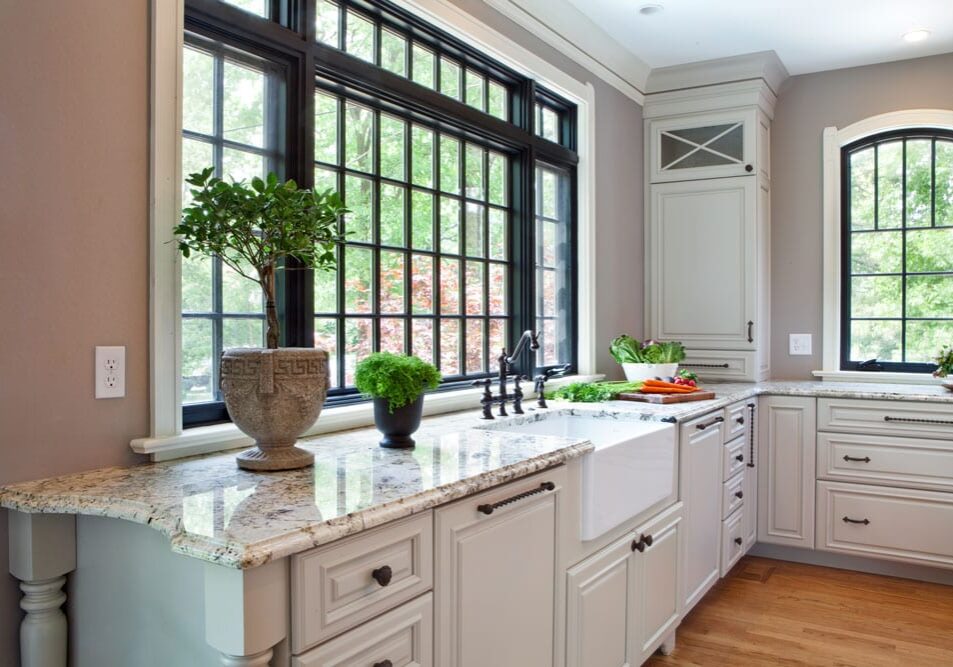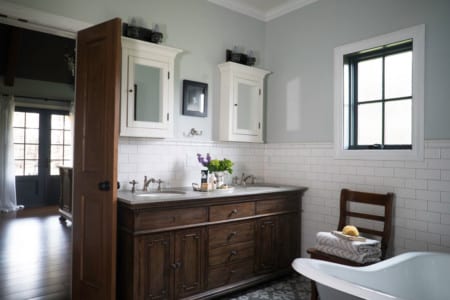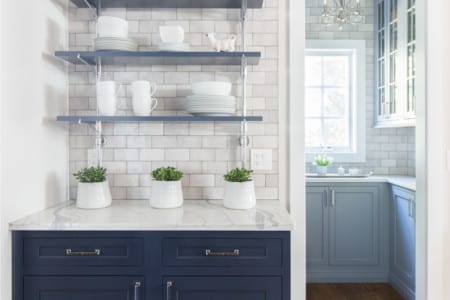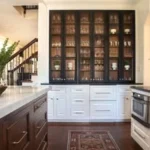What Do I Need to Know When Buying Kitchen Cabinets
March 31, 2017

The Skinny on Cabinets (Basic Construction & Styles)
Kitchen cabinets are available in all shapes, sizes, colors, finishes, and construction levels. It can be confusing and hard to tell them apart. Why does one cabinet line cost more than another? Here is a description of basic cabinetry construction and style options as well as an initial sense of the factors that affect your bottom line.
Framed Cabinet Construction:
A framed cabinet is what we traditionally think of as kitchen cabinets in the United States. The box of the cabinet has a face frame that provides support. When you open the door there is a wood face frame outlining the front of the box to which hinges are attached. This frame provides a small lip all the way around the inside of the cabinet. The frame also helps keep the kitchen (or bathroom) cabinet square so that the doors hang level and the drawers function properly.
Within a framed cabinet product line there are typically 3 types of door configurations:
- Standard overlay: The doors are slightly larger than the cabinet opening, showing the frame of the cabinet when the cabinets are screwed together in a line. This is the least expensive way of making the doors; there is more room for error when the doors are not close together. The biggest visible indicator is the wide space between the doors and drawers.
- Full Overlay: The doors typically have about 1/8” reveal from the edge of the cabinet. This style leaves very little frame showing, so when the cabinets are joined you see almost only door.
- Inset: An inset door is recessed into the face frame creating a flush front on the cabinet. Typically this configuration is only available in a custom cabinet line due to the hand-crafted manufacturing process. Each door is hand-sanded for a custom fit in each opening. Inset doors are often considered to look more like furniture than kitchen cabinetry.
Frameless Cabinet Construction:
Frameless cabinetry is often referred to as European cabinetry. It typically uses the metric unit of measurement and does not have a front frame. It gets it support from using thicker furniture board sides, backs, and tops, or the use of a “hang” rail across the rear of the cabinet. The doors and drawers are attached directly to the box. Because the drawer guides are connected to the box you get a few extra inches of storage within the interior of the cabinets. Because the cabinet is void of a front frame, the only door configuration option is a fully overlaid door or drawer front. You can also create the look of inset doors by using deep panels in between the cabinet boxes.
Cabinet Door and Drawer Styles
The style and construction of the cabinet fronts also affect the cost. Here are some things to consider when choosing the right cabinet to fit your needs:
Door Style:
- Slab: A slab door is exactly what it indicates: a solid slab of wood or a solid panel finished with a veneer. Solid panels can have different edge details and are vastly different in price point. They can be made of glass or finished with high gloss paints. Your finish will depend on the look you prefer and budget considerations. As a rule of thumb, if it’s uncommon, it’s probably expensive!
- Raised panel: A raised panel door simply means a 4-sided frame with a raised middle section. The middle section can have molding details and varied edge details. The more complex, the more costly.
- Flat panel: A flat panel door is a 4-sided frame with a flat center panel. Sometimes this panel is simply a reversed ¾” raised panel. Turn the door around and look; a higher quality door will have a thicker, center panel. This thicker panel helps with the stability of the door and noise when you open and close them. Flat panel doors can be very simple like a Shaker door or have a small amount of detail on the inside edge.
Drawer Style:
The drawers can also be slab, raised, or flat just like the doors. Be careful when choosing hardware. Top drawers with a design may limit the type of hardware you can use due to space constraints in the center panel. Not all cabinet lines will allow you to pick your drawer front. If this is an important detail to you, make sure you check that it is an option.
Cabinet Finishes
More than anything the finish of the cabinet can drive the cost in sometimes surprising ways. The variables are complex and specific to certain cabinet manufacturers. However, one thing to keep in mind is that a factory finish will last the longest. When you purchase kitchen or bath cabinets from a local builder or cabinet constructor, they will typically spray and hand finish the cabinets. It is difficult in these circumstances to control dust and debris in the air that can sometimes affect the finish.
In contrast, custom, semi-custom and stock manufacturers of cabinetry send the parts through dustless environments. Next, the finish is baked on. This process ensures the longevity and consistency of the finish. It also means that manufacturers can offer long-term warranties. In some cases, as with our Mouser line, a lifetime finish warranty is offered.
Painted cabinet finishes cost more than stain. Yes, it’s hard to believe! Specialty finishes such as distressing or glazing will increase the bottom line as well.
Stock, Semi-Custom, and Custom Classifications
Stock, Semi- Custom, and Custom Cabinet classifications are terms manufacturers use to classify the way a cabinet is made. These classifications will loosely help you identify which brands will have more choices and flexibility in the construction of the cabinet boxes.
- Stock Cabinets: Stock cabinets are manufactured in standard sizes using 3” increments to increase or decrease the width. The choices are usually limited regarding styles and colors to keep the cost of manufacturing down. The lead time (the time between the initiation of your order and the completion of production) is often shorter as a result. When designing a space you often have to use what they have available in the spec book. Think “standard.”
- Semi-Custom Cabinets: Semi-Custom Cabinets are a step above the stock cabinet. They usually allow some level of modifications such as an increase or decrease in depth and width. You also will enjoy a wider variety of finishes and door styles to choose from as well as many options for cabinet design and interior storage. The lead time may increase with customization.
- Custom Cabinetry: When designing with custom cabinetry you’re limited only to your mind’s desire. Of course, those dreams can come at a hefty cost and lengthy lead-time as you increase the complexity. Your door style and finish options are plentiful inside a custom line. You also may be able to work within the custom spec book to achieve the look you want without breaking the bank.
A Note About Custom Finishes
One thing to note about custom cabinetry is the difference between a factory’s custom finish and a local cabinet shop’s custom finish. A factory will put a finish on custom cabinetry that will last and carry a strong (sometimes lifetime) finish warranty. The difference maker is that a factory utilizes a dust free finish booth. The guys applying the finish are decked out in hazmat suits and look a little like the CDC in a deadly virus zone! The workers wear the suits, so they do not contaminate the area. The air stays dustless and free of particles.
Then the cabinets go through a gigantic oven that seems like the size of a building! This process heat-cures the finish to ensure its longevity. The bottom line is that the money you save with a local, custom builder isn’t typically worth the wear and tear you see almost immediately on the finish. A factory finish on stock, semi-custom, or custom cabinets is far superior.
Let Us Serve You
In short, there are myriad factors that go into pricing your kitchen cabinets. We have not even touched on wood species! For a deeper dive into this subject, please sign up for one of our consumer classes or contact a member of our design team. We look forward to helping you find just the right cabinet style.









